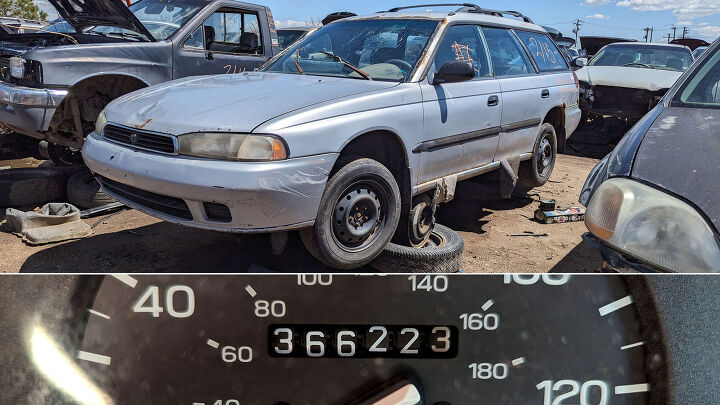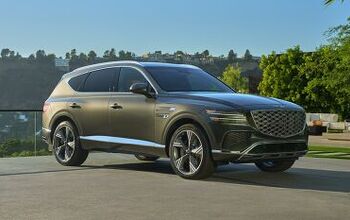Junkyard Find: 1995 Subaru Legacy L Wagon with 366,223 miles

When it comes to junkyard cars with impressively high final odometer numbers, Toyotas, Hondas, Volvos and Mercedes-Benzes seem to be the most likely to have driven better than 400,000 miles during their lives. How about Subaru? Well, today's Junkyard Find is the highest-mile discarded Fuji Heavy Industries product I've ever found.
I live in Colorado, where Subarus are everywhere and the car graveyards are well-stocked with everything from early Leones to mangled WRXs, so I find a lot of these cars.
These days, the most common Colorado junkyard Subarus are members of the Legacy family, mostly Outback wagons of the late 1990s through middle 2000s. Since I own a 2004 Outback wagon, this makes it very easy for me to find parts (which is a good thing because 10-plus-year-old Subarus tend to nickel-and-dime you with broken interior trim pieces and failed electrical components).
Unfortunately for junkyard historians, Subaru only went to six-digit odometers on U.S.-market vehicles in 1981 (1993 for the Justy) and went to electronic odometers (which are tough, though not impossible, to read in the junkyard) for the 2000 model year.
Prior to today's Legacy, the highest-mile junkyard Subaru I'd found was a 1998 Legacy Outback wagon with 341,418 miles. Then there's a 334,735-mile '98 Legacy sedan I haven't yet written about, a 324,780-mile '87 GL wagon and a first-year Impreza wagon with 319,554 miles.
Meanwhile, I don't even bother documenting Hondas or Toyotas showing fewer than 400K miles these days (unless they're interesting for other reasons), and I see plenty of those cars. In my opinion, Subaru components just aren't as good as the ones in Hondas and Toyotas, which pains me to write as the owner of the aforementioned beater Outback wagon plus a Sambar Dias Maleza kei van.
It's common to blame head gaskets and/or transmissions for the untimely demise of Subarus, but I think it's more the accumulation of small, annoying problems that dooms these cars. I've had to replace just about every exterior light bulb socket (plus several taillight harness connectors) in my Outback, for example.
The head gaskets in my 160K-mile Outback are doing fine and its manual transmission means I haven't experienced the drivetrain difficulties that seem to plague two-pedal-equipped members of the 2000-2004 Legacy family (the clutch lasted about 145,000 miles, which I think is respectable for an AWD car). I do all the maintenance at factory-recommended intervals and fix whatever breaks, and it has been a fundamentally reliable (though increasingly battered-looking) machine for the household.
This car may well have been a runner at the end, but not many used-car shoppers today are willing to buy a rusty non-truck with the wrong number of pedals and a scary-looking number on the odometer.
1995 was the first model year for the second-generation Legacy in the North American market, just one year after its Leone predecessor ( known as the Loyale during its final years) finally got discontinued here. The original Legacy had its U.S.-market debut as a 1990 model.
Subaru introduced the Outback package for the Legacy wagon (and the Impreza) in 1995, while the Outback-ized Legacy sedan was called the SUS (Sport Utility Sedan) at first. This car is a Legacy L AWD wagon, which was the starting point for the Outback package (which at the time got you a two-tone paint job, slightly lifted suspension and fog lights).
1995 was also the final year in which American Subaru shoppers could buy new cars with front-wheel-drive. The final four-wheel-drive (as we understand the term today) new Subarus sold here were 1994 models. I've spent years trying to find a junkyard 1995 Legacy or Impreza with front-wheel-drive, so far without success.
The MSRP for this car would have been $16,955, or about $35,233 in 2024 dollars.
The engine is a 2.2-liter SOHC boxer-four, rated at 135 horsepower and 140 pound-feet.
Manual transmissions had fallen way out of favor with American car buyers by the middle 1990s, but this car has the base five-speed manual. The automatic added an even grand to the price of the Legacy L ($2,078 after inflation).
It was built in Lafayette, Indiana, as was the 341K-mile '98 Legacy wagon. That makes this car the eighth-best-traveled vehicle built in the United States that I've documented in a junkyard, just behind a 1996 Toyota Avalon with 389,077 miles.
1995 Subaru Legacy wagon with 360k miles in Colorado junkyard.
1995 Subaru Legacy wagon with 360k miles in Colorado junkyard.
1995 Subaru Legacy wagon with 360k miles in Colorado junkyard.
1995 Subaru Legacy wagon with 360k miles in Colorado junkyard.
1995 Subaru Legacy wagon with 360k miles in Colorado junkyard.
1995 Subaru Legacy wagon with 360k miles in Colorado junkyard.
1995 Subaru Legacy wagon with 360k miles in Colorado junkyard.
1995 Subaru Legacy wagon with 360k miles in Colorado junkyard.
1995 Subaru Legacy wagon with 360k miles in Colorado junkyard.
1995 Subaru Legacy wagon with 360k miles in Colorado junkyard.
[Images: The Author]
Become a TTAC insider. Get the latest news, features, TTAC takes, and everything else that gets to the truth about cars first by subscribing to our newsletter.

Murilee Martin is the pen name of Phil Greden, a writer who has lived in Minnesota, California, Georgia and (now) Colorado. He has toiled at copywriting, technical writing, junkmail writing, fiction writing and now automotive writing. He has owned many terrible vehicles and some good ones. He spends a great deal of time in self-service junkyards. These days, he writes for publications including Autoweek, Autoblog, Hagerty, The Truth About Cars and Capital One.
More by Murilee Martin
Latest Car Reviews
Read moreLatest Product Reviews
Read moreRecent Comments
- Varezhka I have still yet to see a Malibu on the road that didn't have a rental sticker. So yeah, GM probably lost money on every one they sold but kept it to boost their CAFE numbers.I'm personally happy that I no longer have to dread being "upgraded" to a Maxima or a Malibu anymore. And thankfully Altima is also on its way out.
- Tassos Under incompetent, affirmative action hire Mary Barra, GM has been shooting itself in the foot on a daily basis.Whether the Malibu cancellation has been one of these shootings is NOT obvious at all.GM should be run as a PROFITABLE BUSINESS and NOT as an outfit that satisfies everybody and his mother in law's pet preferences.IF the Malibu was UNPROFITABLE, it SHOULD be canceled.More generally, if its SEGMENT is Unprofitable, and HALF the makers cancel their midsize sedans, not only will it lead to the SURVIVAL OF THE FITTEST ones, but the survivors will obviously be more profitable if the LOSERS were kept being produced and the SMALL PIE of midsize sedans would yield slim pickings for every participant.SO NO, I APPROVE of the demise of the unprofitable Malibu, and hope Nissan does the same to the Altima, Hyundai with the SOnata, Mazda with the Mazda 6, and as many others as it takes to make the REMAINING players, like the Excellent, sporty Accord and the Bulletproof Reliable, cheap to maintain CAMRY, more profitable and affordable.
- GregLocock Car companies can only really sell cars that people who are new car buyers will pay a profitable price for. As it turns out fewer and fewer new car buyers want sedans. Large sedans can be nice to drive, certainly, but the number of new car buyers (the only ones that matter in this discussion) are prepared to sacrifice steering and handling for more obvious things like passenger and cargo space, or even some attempt at off roading. We know US new car buyers don't really care about handling because they fell for FWD in large cars.
- Slavuta Why is everybody sweating? Like sedans? - go buy one. Better - 2. Let CRV/RAV rust on the dealer lot. I have 3 sedans on the driveway. My neighbor - 2. Neighbors on each of our other side - 8 SUVs.
- Theflyersfan With sedans, especially, I wonder how many of those sales are to rental fleets. With the exception of the Civic and Accord, there are still rows of sedans mixed in with the RAV4s at every airport rental lot. I doubt the breakdown in sales is publicly published, so who knows... GM isn't out of the sedan business - Cadillac exists and I can't believe I'm typing this but they are actually decent - and I think they are making a huge mistake, especially if there's an extended oil price hike (cough...Iran...cough) and people want smaller and hybrids. But if one is only tied to the quarterly shareholder reports and not trends and the big picture, bad decisions like this get made.


























































Comments
Join the conversation
Subarus can be durable, but they are going to demand more frequent and expensive regular maintenance than your typical Honda or Toyota. I suspect for a lot of third and fourth owners that means the economic equation favors scrapping them a bit earlier.
I just got a 2024 Crosstrek, first car for me that require 6000 K or 6 month service, I have been told I better follow that schedule if i actually want to keep it.
In the last consumer reports survey, it was the only car that got 99 points for reliability, let's hope they are right (:-)